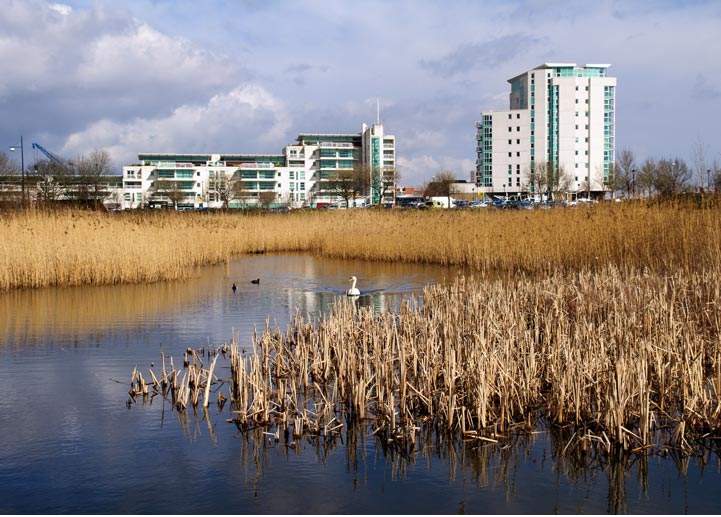It’s a complex issue but policymakers are increasing the pressure on polluters
Managing water quality is wide-ranging and the mechanisms to deliver these practices are equally broad. While top-down regulation has a key role to play, it alone cannot address the breadth and complexity of the issue of water quality. In England, just 16% of waters met the criteria for “good ecological status” in 2020 – no improvement since 2016 and a long way from the government’s ambitions for all rivers to reach good status by 2027. Wildlife and Countryside Link has warned that the water quality of rivers in England is the worst in Europe. In late March 2022, a judicial review to overturn the Welsh government’s decision to designate the whole of Wales as a Nitrate Vulnerable Zone failed. The message is clear that policymakers are ramping up pressure on the polluters.
Defra identifies three main drivers affecting water quality, after physical modification of rivers:
- Agricultural pollution (affecting 40% of water bodies)
- Sewage and wastewater (affecting 36%)
- Run-off from towns, referred to as urban diffuse pollution (affecting 18%)
Farming and water: carrot v stick
At its most broad, water quality on farms is enforced through cross-compliance, but since 2018 the Farming Rules for Water built upon these practices with new rules on managing fertilisers, manures and soils. The whole system of cross-compliance is due to be reformed when BPS payments are delinked and new Land Use Standards are introduced in 2024.
Defra has suggested that farmers could respond to fertiliser shortages by using more organic nutrients such as biosolids, which are a by-product of the wastewater industry
Andrew Teanby, Associate Director, Rural Research
Last autumn, the EA received fierce criticism for its stricter interpretation of the Farming Rules for Water, effectively ruling out spreading organic matter after 1 September on grassland and cereals, with limited application permitted on oilseed rape. Following a widespread backlash and in light of record fertiliser prices in 2022, Defra has clarified the rules and their enforcement. Spreading will be allowed if farmers can demonstrate they plan their applications, balancing the need to make sure the regulations are effective to stop diffuse pollution from getting into rivers, while giving farmers some flexibility.
With the cost of inorganic ammonium nitrate fertiliser around £800 per tonne (at the time of writing), organic matter such as slurry is important to give soil fertility. Defra has suggested that farmers could respond to fertiliser shortages by using more organic nutrients, such as biosolids, which are a by-product of the wastewater industry. However, given the nitrogen content of composted biosolids is just 11kg per tonne, it would require over 73 million tonnes of biosolids to substitute for the total amount of nitrogen fertiliser used in England in 2019. England produces just 3 over million tonnes of biosolids a year; increasing the population by a factor of 20 clearly is not a solution.

Development and water: unlocking opportunity
Nitrogen and phosphorus are key nutrients for crop production. However, if high concentrations leach into watercourses these nutrients can cause excess algae to grow, depleting oxygen in the water and damaging other aquatic life.
The concept of “nutrient neutrality” arose in late 2018 concerning the interpretation of the Habitats Directive. Natural England initially issued guidance preventing residential development surrounding the Solent, where river conditions were “unfavourable”, unless the LPA was certain the impact of the nutrients from the wastewater created on-site could be mitigated. This guidance has since expanded, initially to 32 local planning authorities and in March 2022, a further 43, (see map, below). Any new development in affected areas which consists of overnight accommodation, including permitted development or even campsites, must demonstrate that it is nutrient neutral until such a time as water treatment infrastructure is upgraded to handle more nutrients. This effectively creates a moratorium on all new development that would discharge into a protected water system, but also creates demand for offsets to reduce the amount of nutrients from other sources, such as agriculture.
Of the affected LPAs, 75 sit within England and, for those LPAs where data is available, they have a combined annual housing need of 45,087. Every year these local planning authorities are falling short of this housing delivery target, despite the fact that some of the net additional dwellings are from a pipeline of consented developments before nutrient neutrality took hold.
The fall in housing delivery as a result of nutrient neutrality is exacerbating the misalignment between demand and the speed at which the planning system can deliver new dwellings. The graph illustrates that in the original LPAs affected, the number of consented dwellings fell, (see chart, below). This is still evident despite the nutrient neutrality restrictions applying on a catchment level, and not necessarily affecting the entire LPA area. For the eight LPAs surrounding the Solent, the average number of consented dwellings fell 45% when comparing the periods 2015–2017 and 2019–2021.
Unlocking sites requires housebuilders to pay for mitigation, making these areas less financially viable at a time when competition and lack of supply are causing record growth in values for development land. Until clear guidance is provided to developers and land managers to clarify how to mitigate nutrients and a more uniform approach is taken by LPAs, such as adding the issue as a pre-commencement condition to a planning approval instead of part of an S106 agreement, development in these areas could remain slow and impact the communities that want to live there.
Providing nutrient mitigation, thereby creating “nutrient credits” could present opportunities for landowners in the catchment areas. Mitigation techniques are subject to negotiations with each LPA, but include the creation of wetlands, taking land out of production or the installation of sewage treatment plants on private properties that do not comply with the General Binding Rules covering small sewage discharges.
Water companies: battling public perception
It has been widely reported that the sewerage networks frequently discharge untreated and partially treated sewage into streams and rivers. These overflows are intended to prevent sewage from backing up into properties and their use is subject to permits granted by the EA. The public health and environmental risks of sewage pollution in rivers have become a major cause of public concern. In response, the government strengthened the Environment Act. It has put pressure on water companies and the EA to do more to limit this practice and water companies across the country have said they will rise to the challenge. However, analysis by campaign group Windrush Against Sewage Pollution (WASP) found improvements had yet to be made at any of the 40 overflows prioritised for spill reduction under the government’s 2018 Storm Overflow Assessment Framework.
Water companies are required to report on carbon emissions, as well as environmental performance, so spending on infrastructure to address such issues needs to balance environmental and economic demands. Green infrastructure could offer a solution: projects can be less carbon-intensive in construction, and even carbon-negative in operation. The water companies collectively own approximately 1% of land in England but are impacted by land management decisions over their total catchment areas. These priorities and pressures are likely to encourage collaboration with land managers and investment in nature-based solutions.

Read the other articles within Spotlight: Water below
.jpg)
